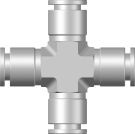Industrial pneumatics can be optimized to reduce the overall energy consumption of your plant. Industrial equipment which generate or utilizes compressed air can be made more energy efficient in a number of ways.
Adopting a few cost cutting strategies can lower your energy bills. This is a significant amount as over half of the total ownership costs of pneumatics are made up of these energy bills.
A constructive evaluation of these applications can thus pay off in both short and long term. Here are three tips to help you start on the savings:
Use the properly sized components
Right sizing is necessary to reduce energy consumption. However, to keep a ‘safety margin’, companies often use oversized components.
This would have been the right thing to do if energy bills were of little to no concerns. Since that is not the case, designs have to be made keeping the benefit versus cost ratio in mind.
Oversizing not only increases air consumption but larger equipment is also fairly expensive. Furthermore, their weight is considerably more which could be a problem if space is an issue or mounting space is needed.
Effective regulation
Pneumatic systems may waste energy if they’re supplying higher pressure than needed by an actuator.
In several applications, for example, the cylinders either only pushes or pulls a load. These cylinders often don’t perform both actions. However, same pressures are set for both retracting and extending strokes, making the process energy inefficient.
Using pressure regulators, you can supply the right pressure and reduce energy consumption by as much as 25%.
Decentralized air supply
Centralized valves require longer air lines which can prove to be cumbersome and energy inefficient. Several manufacturers offer decentralized valves which optimize pneumatic functions. These valves can be directly mounted on the cylinders without the use of hose connectors.
This reduces loss of energy in long lines running to the pneumatic drive. These valve/actuator combinations can decrease as much as 50% of the tubing and 35% of the energy consumption.
Such systems also provide faster response times and comparatively higher cycle frequencies.
Potential savings
Overall machine design and the use of different components affect the potential savings.
For instance, compact designs with correctly sized components can improve air consumption, helping to reduce as much as 15% energy.
Use of pressure regulators for supplying just the right amount of pressure can decrease almost 25% of energy costs. Finally, 35% of costs can be saved by decentralizing the system.
If you’re interested in saving energy and making your pneumatic applications more energy efficient, make sure you use the best quality products.
Check out SealExcel for energy efficient solutions. They offer stainless steel pipe fittings, and check valves, ball valves, purge valves and several other components.


No comments:
Post a Comment